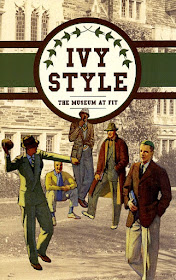Commentary on the intersection of fashion, art, books, history and life by Ingrid Mida.
Pages
▼
Monday, September 24, 2012
Reading Between the Lines at Ivy Style
Ivy Style, an exhibition that considers the origins of the "Ivy League Look"in menswear, opened on September 14, 2012 at The Museum at the Fashion Institute of Technology (FIT) in New York. Presented thematically in vignettes that evoke an Ivy League university campus, including a quad, a dorm room, an athletic club, a chemistry lab and a university shop, the exhibition features around 60 ensembles of menswear that show the evolution of the style from the late 1910s to present day reinterpretations.
Although this classic or preppy style of dressing might seem staid, the "Ivy League Look" was once considered "cutting-edge" and was originally worn by upper class young men from the Ivy League -- Harvard, Yale, Princeton and Columbia. According to legend, representatives from these four universities convened in 1876 to discuss athletic rules and created "a moniker using the Roman numbers for four - IV - and the phonetic pronunciation of the letters "I" and "V".
Ivy Style is a thematic exhibition with focussed on menswear from the Ivy League and its contemporary reinterpretation by such designers as Ralph Lauren, Tommy Hilfiger, Brooks Brothers, Gant, and Thom Browne. This narrow lens gives the exhibition a coherence and focus that belies the considerable research that must have taken place. Menswear is rarely the subject of fashion exhibitions and is often under-represented in museum collections. A close read of the labels in Ivy Style shows that a very significant proportion of garments on display are on loan from designers or individuals, and most of the accompanying period photographs and sports ephemera come from the Carey Collection. Structuring an exhibition around loans suggests a significant investment in both research and time for curator Patricia Mears. Reading between the lines, it would also mean that the research was likely not object based (as would happen within an archive), but instead the desired object was identified from print sources and sought out for loan.
The theme of the show was brought to life in the exhibition gallery space with the focal point being the grass-covered quadrangle, positioned in front of a Gothic-style building façade covered with ivy vines. Along the sides of the room, vignettes of a classroom, a library, a dorm room, an athletic club, and the campus store reinforce the setting and a sound track of A cappella groups, school bands and other music completes the illusion.
The exhibition is both charming and entertaining, but by nature implicitly conservative. A few cutting edge contemporary interpretations of the look are offered up, but are easily overlooked in the montage of looks. And although it might have been true that "Ivy style was once a cutting-edge look worn by young men of means"(as referenced in the press release), I cannot recall how that was conveyed within the exhibition - which means that I either missed that in the exhibition or it was not there.
Included amongst the 60+ ensembles are two women's wear ensembles: a Perry Ellis women's pantsuit and sweater (1981) and a Thom Browne for Brooks Brother's ensemble (Fall 2012). Because there were only two women's ensembles, I was a little confused why they were there. It offered the promise of something exciting, but left me hanging.
In the end, I left the show charmed. Exhibitions of men's wear are few and far between, and I now have a deeper appreciation for the origins of this look.
The Ivy Style exhibition runs until January 5, 2013. For more information, visit www.fitnyc.edu/museum.
References:
Exhibition Phamplet: Ivy Style: The Museum at FIT
Exhibition Press Release: Ivy Style
Notice of copyright:
All text and images on this blog are the copyright of Ingrid Mida, unless otherwise noted. The copying of posts, images and/or text without proper attribution is violation of copyright and legal action will be pursued.

